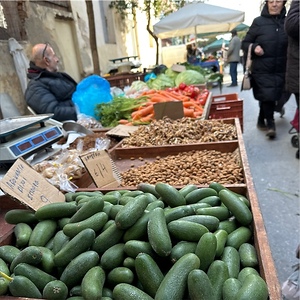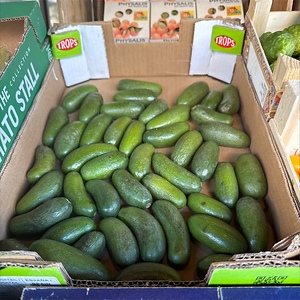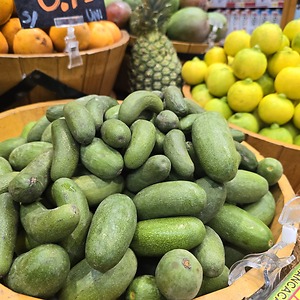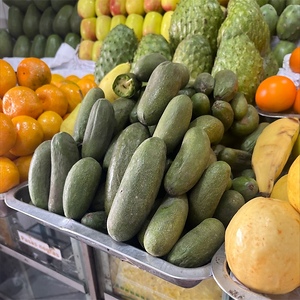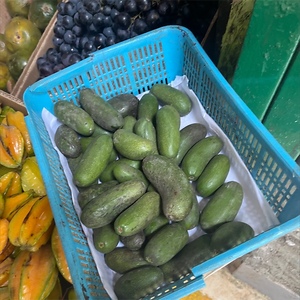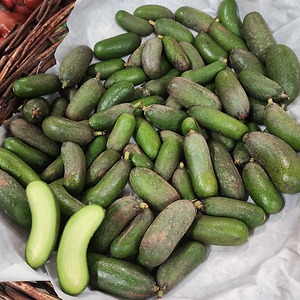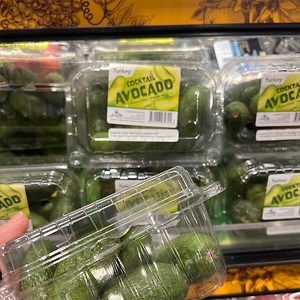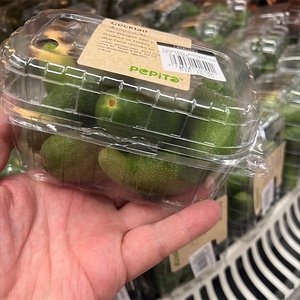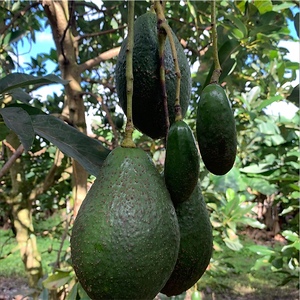


Cocktail Avocados
Estimated Inventory, lb : 0
This item was last sold on : 06/23/25
Description/Taste
Cocktail avocados are small in size, averaging 1 to 3 centimeters in diameter and 5 to 8 centimeters in length, and have a narrow, cylindrical, to elongated shape, similar in size and appearance to baby cucumbers. The avocados sometimes have a slightly curved nature, depending on the variety, and blunt, curved ends. The skin is thin, tightly adhered to the flesh, and has a smooth, glossy, and taut feel. The fruit’s coloring also remains mostly green for some varieties, even when ripe. Underneath the surface, the pale yellow-green flesh is solid and dense with a creamy, buttery, and tender consistency when ripe. Unripe avocados will have a firm, hard nature and should not be consumed until they have matured. Cocktail avocados are generally seedless and lack a central seed. There may be a small, slender cavity in the flesh with a hollow papery sheath, also known as the seed coat. Select fruits that give slightly when squeezed, as Cocktail avocado ripeness is determined by feel, not coloring. Cocktail avocados are edible, raw or cooked, and have a grassy, nutty, and rich taste.
Seasons/Availability
Cocktail avocadoes are available in mid-winter, typically in December.
Current Facts
Cocktail avocados, botanically classified as Persea americana, are a category of avocados belonging to the Lauraceae family. The small fruits have been naturally found on avocado trees throughout the history of avocado cultivation and are created from various genetic factors, climate, and pollination. It is important to note the name Cocktail avocado is a marketing term used to describe fruits that are seedless and small in size. Several varieties of avocados can produce seedless fruits, including Ettinger, Fuerte, Mexicola, Arad, and occasionally Hass. In California, the most common variety producing Cocktail avocados is Fuerte due to the high number of trees grown for retail production. Cocktail avocados are also known as Cukes, Cucumber avocadoes, Avocado Cukes, Seedless avocados, Mini Avocados, Baby avocados, and Avocaditos. The fruits, including the skin, are entirely edible and can typically be consumed in a few bites. Cocktail avocados are said to be developed either by unpollinated blossoms, a natural phenomenon called stenospermocarpy, or, on rare occasions, from weather factors during the blooming period. In the phenomenon of stenospermocarpy, some avocado blossoms are pollinated on the tree, but the seed aborts or disappears at an early stage, causing the fruits to grow without a seed. This limits the fruit’s overall size, creating smaller, seedless avocados. Cocktail avocados are not typically commercially grown but are naturally harvested in small quantities from trees and sold in markets as a novelty. Cocktail avocados have the same flavor and texture as their larger counterparts, the difference lies in their aesthetic qualities, allowing them to be used in culinary preparations as an unusual element or garnish.
Nutritional Value
Cocktail avocados have not been extensively studied for their nutritional properties. Some research says the fruits share similar nutritional properties to regular-sized avocados, just in smaller quantities. Cocktail avocados may be a source of vitamin C to boost the immune system, vitamin E to reduce inflammation, potassium to balance fluid levels within the body, and magnesium to control nerve functions. Avocados also provide vitamin K to assist in faster wound healing, fiber to regulate the digestive tract, and other nutrients, including folate, biotin, riboflavin, niacin, and thiamin.
Applications
Cocktail avocados have a grassy, nutty, and rich taste suited for fresh or cooked preparations. The small fruits are only consumed ripe and can be eaten out of hand as a bite-sized snack. The entire fruit is edible, but the skin may sometimes have a bitter taste. Cocktail avocados are famously marketed by slicing the end of the fruit and then squeezing to remove the flesh from the skin, similar to squeezing a tube of toothpaste. The fruits can be displayed whole on appetizer platters, sliced in half, served with tacos, or arranged on salads. They can also be smashed and spread on toast, layered into sandwiches, or sliced into small medallions and tossed into ceviche. Try pureeing Cocktail avocados with aromatics and herbs to make sauces for grain bowls, roasted meats, or seafood. They can also be diced in fresh slaws, used as a topping over chili, or used whole in dishes as a zero-waste ingredient. Beyond fresh preparations, Cocktail avocados are deep-fried whole and served with dipping sauces or used in any recipe calling for standard-sized avocados. Cocktail avocados pair well with herbs such as cilantro, parsley, and oregano, aromatics including red onion, shallots, garlic, ginger, and chile peppers, citrus juice, and spices such as cumin, paprika, and salt. Whole, unopened Cocktail avocados should be stored in a sealed container and ripened at room temperature. Once ripe, the container is placed in the refrigerator, where the mature fruits will keep for 2 to 3 days.
Ethnic/Cultural Info
Cocktail avocados acquired their memorable marketing name from their ability to be eaten whole. It is said that the name Cocktail evokes an image that the small avocados can be served as hors d’oeurves at parties. In the United Kingdom, Marks & Spencer, a multifaceted retailer, promoted Cocktail avocados in 2017 as a fruit to save the public from “Avocado hand.” This cheeky branding was derived from a statement released by the British Association of Plastic, Reconstructive, and Aesthetic Surgeons that same year. The statement identified that avocados were the reason behind a spike in consumers slicing their hands open due to incorrectly slicing the slippery-fleshed fruits with knives. Many of the injuries reported were severe, and the association recommended that avocados be marked with safety labels. In response to this statement, Marks & Spencer marketed Cocktail avocados as the “safer avocado,” and inspired an increase in social media press around the small fruits.
Geography/History
Cocktail avocados share the same history as regular-sized avocado varieties. Avocados are native to the Americas and have been growing wild since ancient times. The fruits were thought to have been first domesticated in Mesoamerica over 5,000 years ago. When the Spaniards arrived in the Americas, avocados had been spread throughout Central and South America and were a cultivated food source. Avocados were later spread to regions worldwide by Spanish and Portuguese explorers. Cocktail avocados have been naturally growing as long as avocados have been in existence. Historically, the small fruits were regarded as meaningless and were discarded by growers. They were also sold on a small scale in their native growing regions. Over time, farmers began collecting the seedless avocados and worked with retailers to market and distribute them as a novelty. The fruits were initially sold to restaurants and chefs as a rare ingredient, but in 2017, Cocktail avocados were notably found in consumer markets throughout the United Kingdom. The avocados were sold through Marks & Spencer and were imported from Spanish growers. Today, Cocktail avocados are grown worldwide and are sold in markets in Europe, North America, Southeast Asia, and Central and South America. Despite their increased presence in the 21st century, Cocktail avocados remain a seasonal specialty fruit only sold in limited quantities.
Recipe Ideas
Recipes that include Cocktail Avocados. One
| Jennifer's Kitchen |
|
Avocado Butter |
| Joy.Food.Sunshine |
|
Baked Avocado Fries |
Podcast



